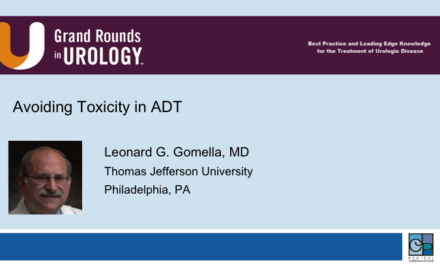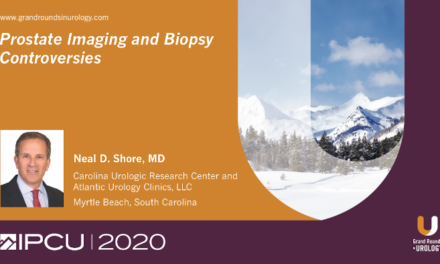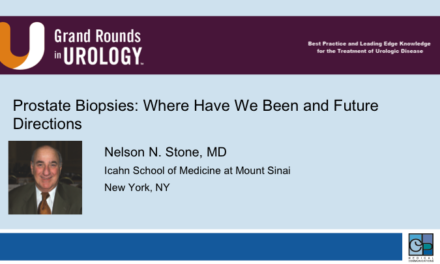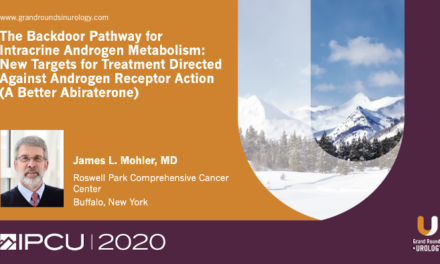Dr. E. David Crawford presented “Identifying the Toothless Lions in Prostate Cancer” at the 26th Annual Perspectives in Urology: Point-Counterpoint, November 10, 2017 in Scottsdale, AZ
How to cite: Crawford, David “Identifying the Toothless Lions in Prostate Cancer” November 10, 2017. Accessed Nov 2024. https://dev.grandroundsinurology.com/identifying-toothless-lions-prostate-cancer/
Summary:
Dr. E. David Crawford, MD, provides an update on prostate cancer surgery and discusses the controversy on local treatments and the lack of conclusive trials for neoadjuvant treatments.
Identifying the Toothless Lions in Prostate Cancer
Transcript:
E. DAVID CRAWFORD: Okay, let me talk a little about surgery and toothless lions and so forth. There’s a lot of controversy about local treatments. The first thing I can tell you is there is no large, randomized clinical trial of surgery versus radiation, okay?
There have been little bits and pieces. Paulson did one years ago. Southwest Oncology group, we tried to do it with Peter Scardino when he was in the group, but there’s a lot of studies like radiation plus or minus four months of hormones, six months of hormones, radiation this, radiation that. The radiation group has done very well at studies with looking at various combinations at chemotherapy and some of the new Anderson biosynthesis inhibitors, anti-Andersons.
We have not done very well at neoadjuvant trials with surgery. We have a few, but they’re not generally well accepted because of the size of the studies and things like that. We have the pivot trial, which was surgery versus observation. We tried a trial of seeds versus observation. We’ve tried trials of surgery versus cryo and many, many other things. It hasn’t been done.
Yeah, I know we make all these decisions based on that. What we have to do—and again, this is sort of the art of medicine too. The treatment of prostate cancer, the patients are influenced by us. I pretty much can talk a person into what I want to most of the time. Most of us who are good salesmen do that. Is that the right thing? No, so if you have—and you see it. There’s plenty of data to support this. If you just bought a proton machine, guess what patients are going to get? If you just got an IMRT machine, guess what patients are going to get? If your hospital just got a robot, guess what patients are going to get?
We influence a lot of what happens, whether right or wrong. The family, the friends—this guy had a radical prostatectomy, and he’s the most miserable person in the world because he leaks all the time or he’s had strictures or his PSA went up, these sorts of things. You see this in support groups and things like that. It’s hard to control for a lot of that stuff.
The media—Mike Cookson just showed you the book about the prostate snatchers and everything else that’s out there that influences our decisions—and newspapers, support groups. I think support groups are great, but I also think they’re horrible in a way because some of the information out there is not balanced. They got a couple of guys. They’re sort of the same ones that are either really happy with their treatment or extremely disappointed with their treatment. You can see that they sort of control the group in a way.
A lot of this stuff is—I’m all for support groups, but there needs to be some medical oversight and balance in there to sort of talk about it. It’s amazing what you see.
Then there’s the side effects. There are people that say there’s no way that—I just got married and I’m 48. I don’t want to have erectile dysfunction, okay? I’m going to go with observation or radiation, things like that. We see this all the time. I remember being on Good Morning, America with Norman Schwarzkopf years ago when he was talking about his cancer. He said, as far as I know, the most common cause of erectile dysfunction is death. You say that to people too.
Anyway, I was going to say marriage, but I shouldn’t say that. Can you x that out of the thing, what I just said? I’ll be in big trouble.
Okay, intent of therapy, is it curative? Is it preventative? The lay progression – – we have patients that have metastatic disease. We’re talking about treating the primary right now. There’s many things that go into it. If you’re a urologist, this is what you tell patients about radiation, okay, is that you’re going to get treated. You’re going to have a rectal problems, bladder problems, things like that. That is, as you well know, not the case today.
Then this was given to me by a radiation therapist, Bob Kagan from Kaiser in Los Angeles, sort of that men that have a radical prostatectomy have a faucet. They’re leaking all the time, drip, drip, drip, drip. We do biases. I could spend an hour or two hours, and I have, giving talks about benefits of surgery, radiation, neoadjuvant, things like that. We don’t have time for that.
I think that it’s not one-stop treatment. That’s one of the things about multi-disciplinary approaches is that you can talk about the different treatments, radiation, surgery, how the patients see their radiation oncologist. There’s a role for cryotherapy. There’s also a lot of other things. We’re going to talk about some of those tomorrow or this afternoon, some HIFU and cryo and things like that.
There are some advantages of everything—advantages to prostatectomy. It’s sort of the gold standard. With the staging, knowledge is power. You know it’s in the prostate, local control.
Radical prostatectomy doesn’t cure if you’re a Gleason 8 or a 6. Whereas, other treatments you have, they’re not so sensitive when they’re high-grade cancers that you have to combine things. There are complications in survival.
Dr. Whitmore, who trained Dr. Donohue right here years ago said this famous saying. Is treatment sufficient for those in whom it is necessary and necessary for those in whom it is sufficient? Is that right? Is that the way he said it, Bob?
- ROBERT E. DONOHUE: Close to it.
- CRAWFORD: Close to it, you always tell me it’s wrong. Anyway, we treat a lot of people that don’t need it. The ones that we do treat, we can’t help them anyway. Let us say that Dr. Whitmore did die of prostate cancer.
Dr. von Eschenbach, who was the Director of the NCI not too long ago, a urologist from Houston, said that the transition in oncology—and I think this is perfect today—is the 20th Century was seek and destroy. The 21st Century is targeted control. That’s cutting down on the symptomatology. Dr. Terlecki mentioned some infections and bacteria in prostate cancer and inflammation and all this other stuff. We might laugh at that.
When I was a resident on general surgery, one of the more common operations we did were antrectomies and pyloroplasties, vagotomies, things like that. When’s the last time anyone did one of those? Anybody remember doing one? We did a lot of them. You know what happened to that?
One pill put that out of business, right? It’s called Tagamet, okay? One pill is going to put prostate cancer out of business. Believe me. If not, it’s going to be an immunological thing. I talked to our residents now about how we’re doing all these robots and this and that. I don’t think you’re going to be doing those in a few years.
We got ways around that. We need to stay on top of the whole disease, embrace it, and so forth. This is one of the things. Now the male lumpectomy. What is that? This is not the whole prostate, but just the cancer.
How many times have you have you had a patient say to you, doc, why do you have to take my whole prostate out? Why can’t you just treat the cancer? It’s multi-focal and whatever’s causing it’s going to come back here and there. We say that, but really? Now we have ways to do that. We’ve been doing this for over a decade, and now it’s one of the hottest things you see in all the journals, the focal therapy and things like that.
What we did, and we’ve done almost 1,000 now, are transperineal mapping biopsies. What those are that you go through the prostate with a template at 5 mm intervals. We’ll do up to 100 biopsies. Our record is 180. Then we 3-D reconstruct that prostate and put it together. It’s a very labor-intensive procedure we do. This is the ultrasound, the biopsies. We go through there. We label every one of these. It goes in the separate thing and so forth. Then we have our computer here. Then this is what we get back. We get these 3-D images. Here’s the cancer, the 7s and 6s and so forth. This is one we just did in June. You can look at it in 3-D and say, okay, here’s all our needles and everything. Maybe, we’ll put a cryo probe right here and one right here—that’s it, a lot of these are anterior tumors—and just treat them. It makes sense. It’s the male lumpectomy. It resonates. A lot of the stuff we’re doing is going to be different.
ABOUT THE AUTHOR
Researcher-physician E. David Crawford, MD, has devoted his career in medicine to educating the public about men's health issues and finding effective techniques and procedures to address prostate cancer, the most common malignancy affecting men in the United States.
He is currently a Professor of Urology at the University of California, San Diego, and emeritus distinguished endowed Professor of Surgery, Urology, and Radiation Oncology, and Head of the Section of Urologic Oncology at the University of Colorado Anschutz Medical Campus in Aurora, Colorado. Dr. Crawford received his medical degree from the University of Cincinnati and his postgraduate training included an internship and residency in urology at the Good Samaritan Hospital in Cincinnati. He subsequently completed a genitourinary cancer fellowship at the University of California Medical Center in Los Angeles.
Dr. Crawford is an internationally recognized expert in benign prostate hypertrophy, urologic cancers, and in particular, prostate cancer. He has conducted research in the treatment of advanced bladder cancer, metastatic adenocarcinoma of the prostate, hormone-refractory prostate cancer, and other areas of urological infections and malignancies. He has authored or coauthored over 810 scientific articles, has published seven textbooks, authored over 60 book chapters, and provided more than 2,200 educational talks for patients and physicians.
In an effort to raise public awareness about prostate health, Crawford in 1989 founded the Prostate Conditions Education Council (PCEC). The non-profit organization is comprised of a consortium of leading physicians, health educators, scientists, and men's health advocates. PCEC's advocacy for free or low-cost prostate screening has affected the lives of millions of American men. He currently chairs the PCEC.
Crawford is an active member of many national and international organizations, including the American Society of Clinical Oncology, the American Urological Association (AUA), and the American Association for the Advancement of Science. Within the AUA, he has been a member of the Committee to Study Urologic Research Funding and the prostate cancer clinical trials subcommittee. Crawford served on the board of governors, the scientific advisory board of the Southwest Oncology Group, and was chairman of the Genitourinary Cancer Committee for 27 years. This group is the largest clinical trials group in the world.
Crawford's involvement in the national prostate cancer arena has been widely recognized. He has received many honors and awards, including the CAP Cure Annual Award for Scientific Presentation in 1999 In 1997, he was presented with a 'Freddie Award" at the AMA International Health and Medical Film Competition for the program, ITV: The Cutting Edge Medical Report (Prostate Cancer: Understanding, Diagnosing, and Defeating), which Crawford hosted with special guest, retired General Norman Schwarzkopf.
Crawford again won a prestigious 'Freddie Award" 5 years ago... He is a member of Best Doctors of America and was named Healthcare Provider of the Year in the Denver Metro area by the Denver Business Journal.
He has been recognized as one of the Best Doctors of America for the past two decades and is recognized as one of the top 20 urologists in the country, for men, by Men’s Health Magazine. In 2018 he received the honor of being named the Distinguished Alumnus of the Year from the University of Cincinnati School of Medicine. In May of 2019, he received the Presidential citation from the American Urological Association recognizing for his “tireless role in genitourinary cancer research that has benefited countless urologic cancer patients.” He accepted the position of Editor in Chief of Grand Rounds in Urology in June of 2019. In 2021, he was the recipient of the Merle Stringer, M.D. annual award for excellence in medicine by the Florida State Medical Association.





